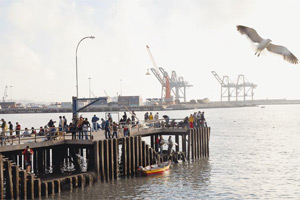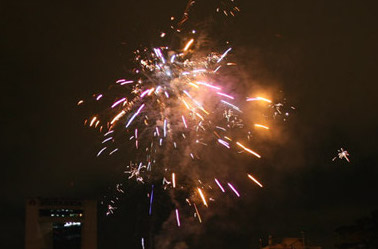The Region of Valparaiso is one of the main destinies of national and foreign tourist in the country’s central zone, for there are more than 130 beaches lengthwise the littoral. Also, it has other attractions: at the Andean Ranges, the ski resort called Portillo, and in the valleys, villages of folklore, religious, artistic, crafty interests, among others.
Province of Petorca
– Los Molles: this beach resort is located in the northern opart of the region and is well known for its white sands and for diving.
– Papudo: is a community which their main atractions are the beach resorts Playa Grande and Playa Chica. Also, outstands the fishing resorts, the old big houses and the church Nuestra Señora de las Mercedes, declared Monumento nacional in 1995.
– Zapallar: this beach resort is located 10 km southwards Papudo. Its beaches are suitable for water sports.
– Petorca: at 190 km westwards Valparaiso, this city was founded on April, the 4th, 1753 by Domingo Ortiz de Rozas, who called originally Villa Santa Ana de Briviesca, honoring his wife. Its main tousist actraction is the Nuestra Señora de la Merced church.
– Cachagua: is an exclusive beach resort extending for 5 km and has as main attraction, the island likewise named. Also, inland are manufactured thread craftsmanship and tablecloth embroidery, bed sheets, napkins, among others.
– La Ligua: is located inland this province and is renown for its candies and original weavings. Besides, in the city is possible to visit the Museum likewise named, which preserves the inheritance left by the pre-Hispanic inhabitants of the zone.
– Cabildo: is located at 140 km from Valparaiso and is characterized for having areas of archeological interest, such as petroglyphs (near the Alicahue village).
Province of San Felipe of Aconcagua
– San Felipe: is the provincial capital and among its main tourist attractions are the Casa Mardones, XVIII century colonial mansion and churches such as the San Francisco de Curimon, El Almendral, ola del Buen Pastor and the city’s cathedral. All this religious constructions are national monuments.
– Termas of Jahuel: is located in the Andean foothills at 19 km from San Felipe city. They are well known because its waters would alleviate breathing, rheumatic, liver, and digestive diseases, among others. There is a Hotel in the place, a spa and fields for different games.
– Catemu: this city was founded on December, the 22nd. 1891 by Enrique Garcia Huidobro y Cazzote. The main attractions are its farm workers´ festivities.
Province of Quillota
– Quillota: this city is known for having very high quality grounds for agriculture, especially, custard apples, avocados and lucumas farming. Besides, in this place outstands the Archeological Historical Museum and the Casa Colorada, where Bernardo O´Higgins lived.
– Olmue: this city is well known for its climate and for its famous huaso festival, one of the best known in our country.
– Ocoa: at the foothill of the La Campana hill is located this little village which main attraction is that is surrounded by a great quantity of Chilean palms.
Province of Valparaiso
– Viña del Mar: this city is internationally well known for its beautiful beaches; thus, is one of the favorite destinations of national as well as foreign tourists. It was born from the fusion of two haciendas, Siete Hermanas and Viña del Mar. They were separated by the Marga Marga marsh, which currently transverses the city. Besides its beaches, one may visit museums like the Museum of Fine Arts, the Francisco Fonck Archeological Museum, the Natural History Museum and the Rioja Palace Museum. In February, the Quinta Vergara plays host to the Festival de la Cancion (Song Festival), the most internationally renowned one around the world.
– Valparaiso: this port is surrounded by 44 hills and is a great tourist draw thanks to its beautiful architecture. For this reason, it was declared a World Heritage Site by Unesco, especially the city’s old quarter. Among the most important buildings that have the category of national monuments, one may find the Matriz church and the plazuela de Santo Domingo (Santo Domingo small square); Echaurren square and its surroundings; Prat pier, Sotomayor square and Justicia square; Prat street, plazuela Turri and its surroundings and Concepcion and Alegre hills.
– Juan Fernandez Archipelago: it is located 674 km from the port of San Antonio and is made up by three islands, which have a total surface area of 147 km2: Robinson Crusoe, Alejandro Selkirk and Santa Clara.
Province of San Antonio
– Algarrobo: this beach community is known for its calm waters, los Pingüinos or Pajaros Niños island, the yacht club and Las Cadenas and El Pejerrey beaches.
– El Quisco: this comuna (county) is comprised of several important spots, such as the beach town that bears the same name, Punta de Tralca, el Totoral (which has an archeological museum) and isla Negra.
– Las Cruces: this beach town was founded in the XIX century and owes its name to the crosses placed by its inhabitants after a shipwreck. It has two extensive beaches: Las Salinas and Playa Larga.
– Cartagena: in the early XX century, it was a destination exclusively reserved for the country’s aristocratic families. However, today, it is one of the coast’s most popular spots. Its two main beaches are playa Chica and playa Grande, separated by a rock known as Roca de los suspiros (Rock of the sighs).
– San Antonio: it the second most important port in the country. It has Barracas and Llolleo beaches, as well as the Punta Panul lighthouse, which serves as a guide for the ships entering the area.
– Rocas de Santo Domingo: this exclusive beach community is found south of the mouth of the Maipo river. It is known for its strong waves and wind. For this reason, the use of a few areas of the beach is restricted.








